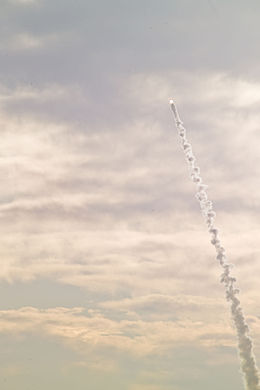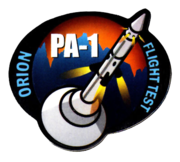
The PGM-11 Redstone was the first large American ballistic missile. A short-range ballistic missile (SRBM), it was in active service with the United States Army in West Germany from June 1958 to June 1964 as part of NATO's Cold War defense of Western Europe. It was the first US missile to carry a live nuclear warhead, in the 1958 Pacific Ocean weapons test, Hardtack Teak.

White Sands Missile Range (WSMR) is a United States Army military testing area and firing range located in the US state of New Mexico. The range was originally established in 1941 as the Alamogordo Bombing and Gunnery Range, where the Trinity test site lay at the northern end of the Range, in Socorro County near the towns of Carrizozo and San Antonio. It then became the White Sands Proving Ground on 9 July 1945.

Cape Canaveral Space Force Station (CCSFS) is an installation of the United States Space Force's Space Launch Delta 45, located on Cape Canaveral in Brevard County, Florida.

AS-201, flown February 26, 1966, was the first uncrewed test flight of an entire production Block I Apollo command and service module and the Saturn IB launch vehicle. The spacecraft consisted of the second Block I command module and the first Block I service module. The suborbital flight was a partially successful demonstration of the service propulsion system and the reaction control systems of both modules, and successfully demonstrated the capability of the command module's heat shield to survive re-entry from low Earth orbit.
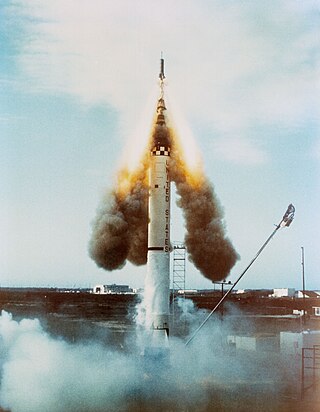
Mercury-Redstone 1 (MR-1) was the first Mercury-Redstone uncrewed flight test in Project Mercury and the first attempt to launch a Mercury spacecraft with the Mercury-Redstone Launch Vehicle. Intended to be an uncrewed sub-orbital spaceflight, it was launched on November 21, 1960 from Cape Canaveral Air Force Station, Florida. The launch failed in an abnormal fashion: immediately after the Mercury-Redstone rocket started to move, it shut itself down and settled back on the pad, after which the capsule jettisoned its escape rocket and deployed its recovery parachutes. The failure has been referred to as the "four-inch flight", for the approximate distance traveled by the launch vehicle.

Little Joe II was an American rocket used from 1963 to 1966 for five uncrewed tests of the Apollo spacecraft launch escape system (LES), and to verify the performance of the command module parachute recovery system in abort mode. It was named after a similar rocket designed for the same function in Project Mercury. Launched from White Sands Missile Range in New Mexico, it was the smallest of four launch rockets used in the Apollo program.
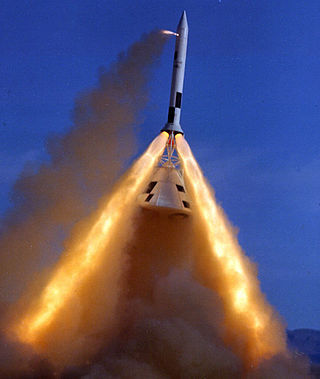
A launch escape system (LES) or launch abort system (LAS) is a crew-safety system connected to a space capsule. It is used in the event of a critical emergency to quickly separate the capsule from its launch vehicle in case of an emergency requiring the abort of the launch, such as an impending explosion. The LES is typically controlled by a combination of automatic rocket failure detection, and a manual activation for the crew commander's use. The LES may be used while the launch vehicle is still on the launch pad, or during its ascent. Such systems are usually of three types:

The Martin MGM-1 Matador was the first operational surface-to-surface cruise missile designed and built by the United States. It was developed after World War II, drawing upon their wartime experience with creating the Republic-Ford JB-2, a copy of the German V-1. The Matador was similar in concept to the V-1, but it included a radio command that allowed in-flight course corrections. This allowed accuracy to be maintained over greatly extended ranges of just under 1000 km. To allow these ranges, the Matador was powered by a small turbojet engine in place of the V-1's much less efficient pulsejet.

The Minotaur is a family of United States solid fuel launch vehicles derived from converted Minuteman and Peacekeeper intercontinental ballistic missiles (ICBM). They are built by Northrop Grumman via contract with the Air Force Space and Missile Systems Center's Space Development and Test Directorate (SMC/SD) as part of the Air Force's Rocket Systems Launch Program which converts retired Intercontinental Ballistic Missiles into space and test launch systems for U.S. government agencies.

A rocket garden is a display of missiles, sounding rockets, or space launch vehicles, usually in an outdoor setting. The proper form of the term usually refers to the Rocket Garden at the Kennedy Space Center Visitor Complex.

A boilerplate spacecraft, also known as a mass simulator, is a nonfunctional craft or payload that is used to test various configurations and basic size, load, and handling characteristics of rocket launch vehicles. It is far less expensive to build multiple, full-scale, non-functional boilerplate spacecraft than it is to develop the full system. In this way, boilerplate spacecraft allow components and aspects of cutting-edge aerospace projects to be tested while detailed contracts for the final project are being negotiated. These tests may be used to develop procedures for mating a spacecraft to its launch vehicle, emergency access and egress, maintenance support activities, and various transportation processes.

The Orion Multi-Purpose Crew Vehicle is equipped with a launch escape system. Orion has several abort modes. Some of these may not use the LAS itself, but would use the second stage of the SLS, or even the Orion vehicle's own propulsion system instead.

Ares I-X was the first-stage prototype and design concept demonstrator of Ares I, a launch system for human spaceflight developed by the National Aeronautics and Space Administration (NASA). Ares I-X was successfully launched on October 28, 2009. The project cost was $445 million.
A pad abort test is a kind of test of a launch escape system which conducted by setting the system along with the spacecraft still on the ground and let the system activate to carry the spacecraft flying away, then separate in the air and make the spacecraft land safely. The purpose of the test is to determine how well the system could get the crew of a spacecraft to safety in an emergency on the launch pad. As the spacecraft is set still on the ground, the test is also called "zero-altitude abort test" in against "high-altitude abort test".

The Max Launch Abort System (MLAS) was a proposed alternative to the Maxime Faget-invented "tractor" launch escape system (LES) that was planned for use by NASA for its Orion spacecraft in the event an Ares I malfunction during launch required an immediate abort.
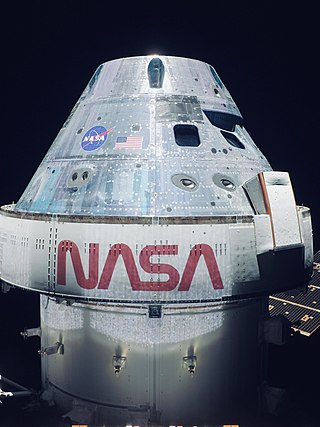
Orion is a partially reusable crewed spacecraft used in NASA's Artemis program. The spacecraft consists of a Crew Module (CM) space capsule designed by Lockheed Martin and the European Service Module (ESM) manufactured by Airbus Defence and Space. Capable of supporting a crew of four beyond low Earth orbit, Orion can last up to 21 days undocked and up to six months docked. It is equipped with solar panels, an automated docking system, and glass cockpit interfaces modeled after those used in the Boeing 787 Dreamliner. A single AJ10 engine provides the spacecraft's primary propulsion, while eight R-4D-11 engines, and six pods of custom reaction control system engines developed by Airbus, provide the spacecraft's secondary propulsion. Orion is intended to launch atop a Space Launch System (SLS) rocket, with a tower launch escape system.

The RTV-A-3 NATIV was an experimental missile developed by North American Aviation for the United States Air Force in the late 1940s to test and evaluate guided missile technologies. The North American Test Instrumentation Vehicle (NATIV) was developed as part of the MX-770 program which was created towards the end of WWII with the intent of developing a long range missile.

Ascent Abort-2 (AA-2) was a test of the launch escape system (LAS) of NASA's Orion spacecraft.
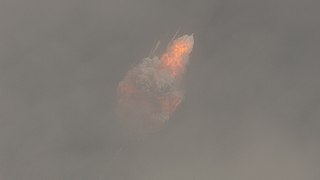
SpaceXCrew Dragon In-Flight Abort Test was a successful test of the SpaceX Dragon 2 abort system, conducted on 19 January 2020. It was the final assessment for the Crew Dragon capsule and Falcon 9 launch system before they would be certified to carry humans into space. Booster B1046.4 and an uncrewed capsule C205 were launched from Launch Complex 39A (LC-39A) on a suborbital trajectory, followed by an in-flight abort of the capsule at max Q and supersonic speed. The test was carried out successfully: the capsule pulled itself away from the booster after launch control commanded main engine shutdown and landed safely.
